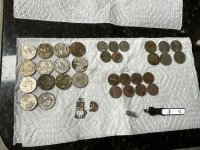sodetraveler
Sr. Member
"BTW Ground lip Mason jars were blown is semi-automatic bottle-making machines. No gaffer was involved". Harry, I never knew that!
Interesting indeed!

However, from the picture it is fairly clear that the lip of this particular mason jar is machine made and was never ground (i.e. this is not a ground lip).
Is there an identical Ball Mason (i.e. same script) that is ground? I'm pretty sure I've seen some in the past, but "pretty sure" isn't quite definitive enough for me!
It also occurred to me that the common "PATENT NOV 30th 1858" Mason jars (not Ball) with ground lips couldn't possibly have been machine made......at least not in 1858!
Seems like there may be more to say on this subject!




